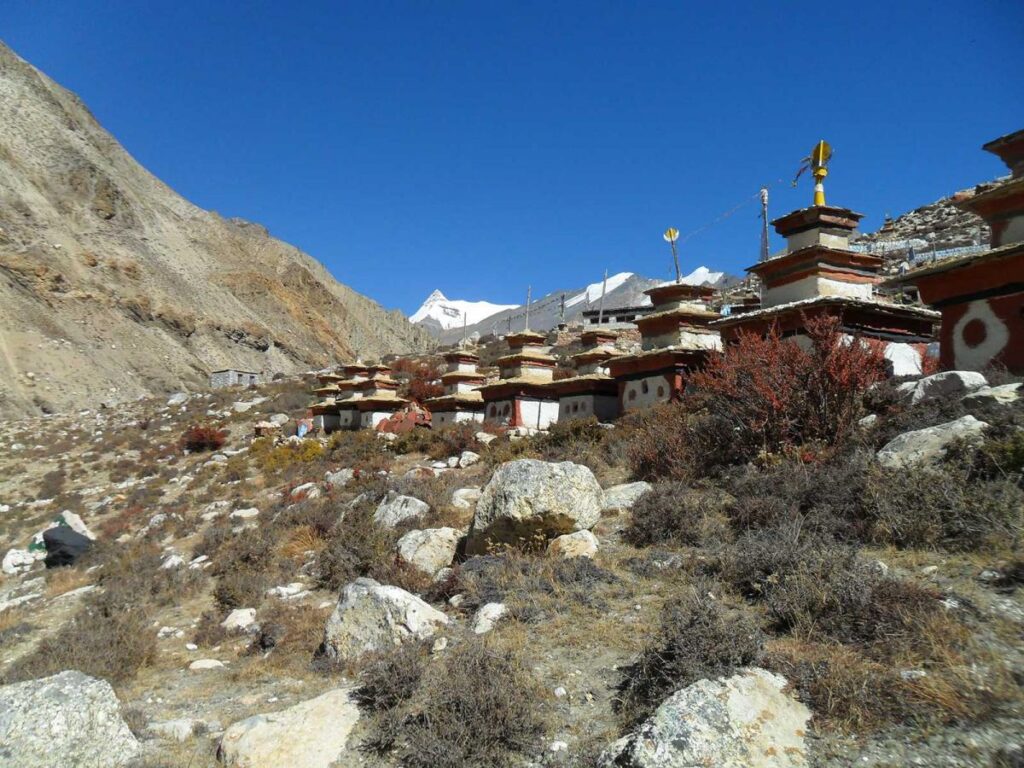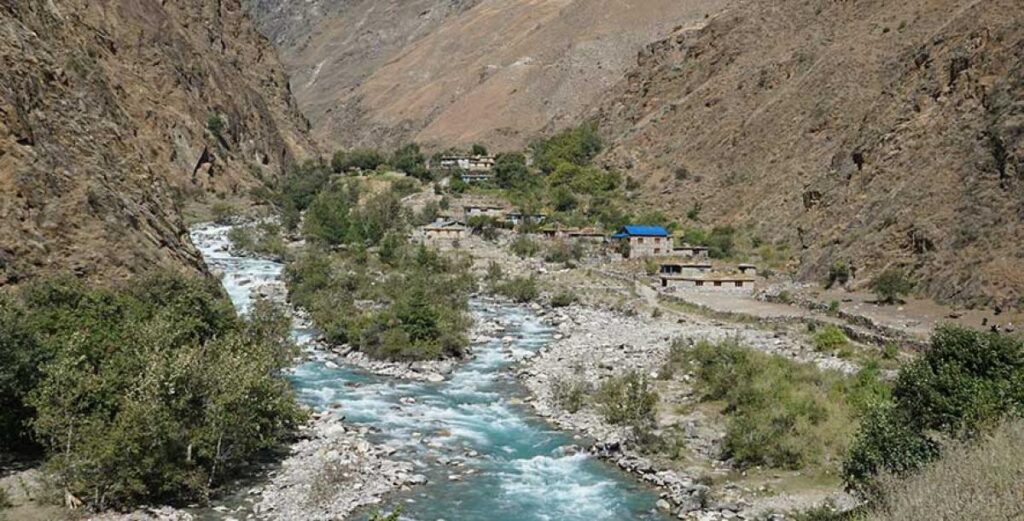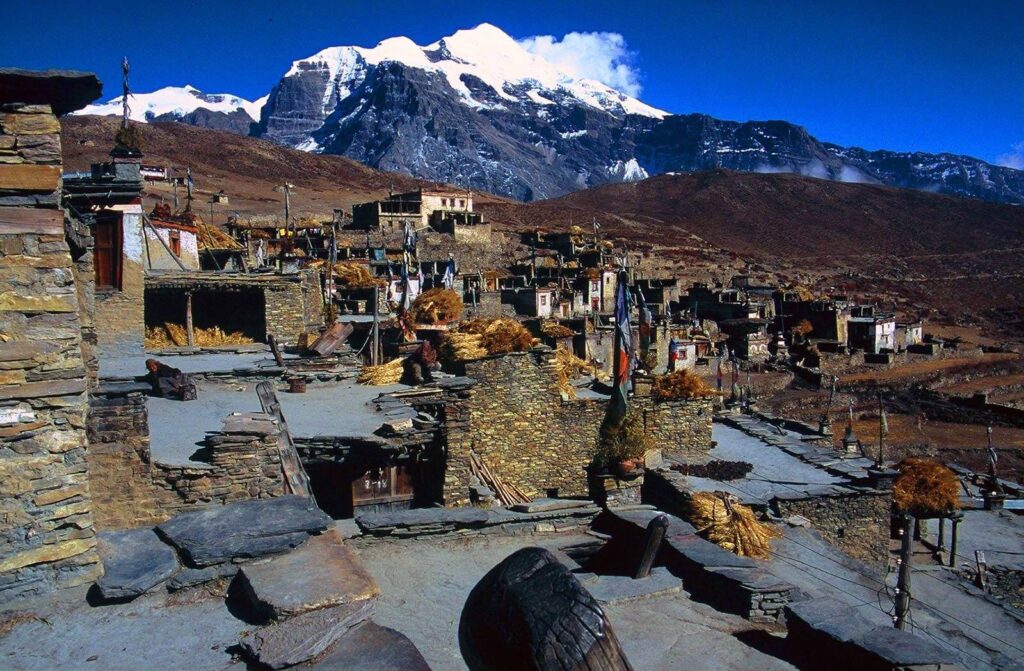Nar Phu Trek





OVERVIEW
The Nar Phu Trek has only been open for exploration since 2002 and offers an extraordinarily pristine cultural and scenic experience that is all the more remarkable given its proximity to the famous and well-traveled Annapurna circuit. One of Nepal’s true hidden valleys, its rugged landscapes and ancient villages bordering on Tibet have lain in peaceful solitude for years from the outside world, with relatively few trekkers making the journey to one of the last truly untouched regions in the Himalayas.
The trek begins properly at Besisahar and follows the stock route for the Annapurna Circuit through to Koto before branching away eastward towards Nar Phu Valley. The trail leads along the Nar Khola River and through a narrow gorge before arriving at the small settlement of Odar (which translates to ‘Cave’), a convenient point for a lunch stop at one of the newly constructed tea houses. From Odar the path heads out through thickets of pine, rhododendrons, and bamboo, with the soothing delights of a hot spring en route to bath in for a refreshing break. From there we head to the picturesque village of Meta and its impressive landscapes and view of the monastery at Nar Phedi in the distance.
The following day’s journey to Phu offers some of the most memorable and unspoiled views on the trek as the trail passes below the daunting slopes of Kangaru Himal and Chyakhu before winding on through the village of Kyang. Phu itself is a remarkable and impressive village that seems as much a bastion against the forces of time as the harsh Himalayan elements, with a known history that dates back to at least the 5th century. The structures are like building blocks set side by side and seemingly one on top of the other along the sloping hill at the heart of the village, creating the semblance of terraced fields of stone. Replete with the obligatory Mani walls, prayer wheels, and its fascinating monastery, the village is a treasure house of Tibetan culture frozen in time that intrigues and beguiles at every turn and stairway, particularly for photographers.
Phu also serves as a gateway to the mountain of Himlung (7126m) and its base camp at an altitude of 4920m. With a rest day set aside for Phu, the opportunity exists to either hike to the base camp and its impressive views and glacial surroundings or simply relax in Phu for the day and use the time to further explore the labyrinthine village and its many charms.
From Phu, the trail heads westward to Nar Phedi and its monastery for a fascinating overnight stay, and on the following day climbs steeply to the impressively sited village of Nar – yes, it’s confusing! The village offers more stunning views of the Himalayas, as well as the culturally rewarding experience of observing the local people engaged in a variety of activities unique to the area. The trek through the valley culminates with the climb up to Kang La pass (5360m) and the steep and rocky descent to Ngawal on the Annapurna Circuit trail. The option exists to continue on the circuit up to and over Thorong La pass or head towards Mesokanto La as an alternative. Otherwise, the trek concludes by hiking back down the trail to Chame and the return drive to Pokhara or Kathmandu.
Nar Phu Trek is undoubtedly one of the premier destinations in the Himalayas for those seeking a glimpse into a region of raw beauty and Tibetan culture that’s a throwback to a distant past, one that even Tibet itself has long since forgotten about.
COUNTRY
Nepal
DURATION
14 Days
DIFFICULTY LEVEL
Strenuous
ACTIVITY
Trekking/Hiking
GUIDE
English Speaking, Trained
PRICE
US$ 2200
TRIP HIGHLIGHTS
- Superb vistas, diverse flora, and fauna, the isolated landscape along with a pristine Tibetan culture
- Hike to Himlung Base Camp
- Memorable visits to the highly unique villages of Nar and Phu
- Kang La Pass
- Overnight stay in the monastery
ITINERARY
-
DAY 1 | Welcome at airport and transfer to the hotel
Welcome at the airport then transfer to your Hotel.
-
DAY 2 | Free day for final trekking preparation
Final trekking preparation then spends a day the way you prefer.
-
DAY 3 | Kathmandu to Jagat by drive 8-9hrs/208km.
Pick up from your hotel and drive to Jagat, where we rest up for the overnight in preparation for the next day’s trekking.
-
DAY 4 | Jagat to Dharapani 6hrs/16km.
Another reasonable day of hiking through a diverse landscape of farmland, river crossings, and numerous waterfalls. The pretty village of Tal (meaning Lake) gives us time to pause before finishing up for the day at Dharapani, one of the region’s key trekking hubs.
-
DAY 5 | Dharapani to Koto 5-6hrs/13km.
The morning sees the trail climbs steadily through forested slopes towards Timang, one of the trek’s scenic outlooks with fine views of Manaslu, Annapurna II, and Lamjung Himal. The day finishes at Koto, the gateway to Nar Phu where we check in with our permits at the local field office.
-
DAY 6 | Koto to Meta 8hrs/15km.
The real adventure begins as the trek leads into the restricted and rarely visited valley of Nar Phu, a semi-arid region very similar geographically to Manang yet one with its own highly unique and largely untouched Tibetan culture.
For those who have flexibility on holiday, we recommend having the first acclimatization day in Meta where you may discover the Kanggaru Base Camp if you are interested.
-
DAY 7 | Meta to Phu 8hrs/16km.
The day’s stunning landscapes and secluded nature of the trail are only superseded by the magic of coming upon the medieval walled village of Phu at day’s end, a cubist painting comes to the life of block-like homes and structures ringed around the core hill.
-
DAY 8 | Side trip to Himlung Base Camp (7 hrs, 4920m/16142ft) then back to Phu village for overnight.
A rest day at Phu allows us to explore the heights and spectacular views on offer of Himlung Base Camp, with plenty of time left over in the afternoon to relax and wander the myriad laneways of Phu and bask in the genuine warmth, hospitality, and traditional culture of the local people.
-
DAY 9 | Phu to Nar Phedi where we can have unique experience of staying overnight in Monastery 6hrs/15km.
The trek to Nar Phedi offers further opportunities to take in the unique landscape of the valley, while the village provides a fascinating opportunity to stay overnight in the nearby monastery.
-
DAY 10 | Nar Phedi to Nar Village 2-3hrs/5km.
Nar is almost as impressive as Phu in both size and scope, with a picture-perfect setting atop a hill that provides superb views of the Himalayas.
-
DAY 11 | Nar to Kang La Pass (5320m/17454ft) then descend to Nagwal 8hrs/15km.
A day to savor, as well as a day to test one’s resolve. The trail moves steadily away from Nar Village and climbs through the most remote area of the valley to Kang La and the streaming prayer flags that mark the apex of the trek. After pausing to celebrate the moment, take appropriate pictures, and admire the glorious views, we head over the pass to begin the steep descent to Ngawal, the village which marks our return to the standard route for the Annapurna Circuit.
-
DAY 12 | Nagwal to Chame 7hrs/21km.
A quick descent back down the Annapurna route brings us to Chame, the administrative center for the Manang region.
-
DAY 13 | Drive back to Kathmandu( 12-13hrs/247km), Pokhara 10-11hrs/149km by Jeep/bus.
A local jeep takes us as far as Besisahar, after which we switch to another transportation for the journey to Kathmandu.
-
DAY 14 | Farewell
Join with different trips or farewell
INCLUDE
Cost Includes
- Complementary airport pick-up and drop-off
- Complementary welcome dinner
- Two-night stay on arrival in Kathmandu with breakfast included (on a twin-share basis)
- All necessary trekking permits, such as the Nar Phu special permit, the Annapurna conservation area permit, and the TIMS card
- All accommodations during the trek
- Three meals a day during the trek
- A cup of tea or coffee each time with the meal
- Fresh fruit each day, if and when available
- First-aid kit
- Drive to Jagat from Kathmandu.
- Drive back to Kathmandu or Pokhara by bus or Jeep.
- Staff insurance, meals, accommodation, equipment, transportation, etc.
- Agency service charge and government tax (VAT)
- Certificate of achievement, if needed
Cost Excludes
- International airfare and Nepal visa fee
- Lunch and dinner in Kathmandu
- Porters to carry your backpacks (we provide porters on request)
- Personal Insurance, personal expenses, loss of property and theft, etc.
- Sightseeing costs (temples, monasteries entrance fee, etc.)
- All beverages, snacks, and additional expenses such as laundry, hot showers, battery charging, Wi-Fi, etc.
- Tips for staff
FAQs
- Kindly take permission while taking photos of locals
- Respect the local culture
- Proper trekking gears
- Take some snacks with you in case of if you got some kind of sickness or quick energy
- Take a wall side or safe side while passing donkeys on the way
- If you are in the landslide area please head up around and pass without delay
- Better to avoid alcohol or smoke above 3000 m.
- Drink more than 3 liters of water per day
- Water purification tablets or filter machine
- Be aware of altitude symptoms
- Minimum 2 trekkers require to obtain Nar Phu Valley special permits
- Extra Nepali Rupees just for unusual circumstances or extra snacks in tea houses
- Proper acclimatization is essential to hit the goal
